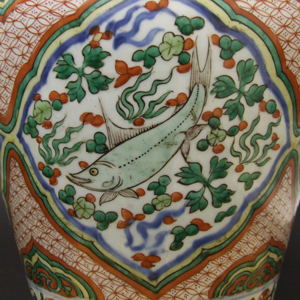
SHUNZHI 1644 – 1661 Transitional Porcelain
A Transitional Porcelain Wucai Jar and Cover, Shunzhi Period 1644-1661. The Transitional Porcelain Baluster Jar is Decorated in a Rich Underglaze Cobalt Blue and Strong Bright Overglaze Enamels. The Decoration is of Fish, Including Carp, Swimming Among Aquatic Plants within Panels.
SOLD
- Condition
- A fine rim crack to the neck c.48 mm. Some glaze chips and fritting to the cover.
- Size
- Height : 37.8 cm (15 inches)
- Provenance
- N/A
- Stock number
- 23053
Information
Wucai :
Wucai means five coloured decoration. This consists of the overglaze enamel colours ; red, green, and yellow, underglaze cobalt blue and the white of the porcelain itself.
Shunzhi 1644-1661 :
The Shunzhi emperor (lived 1638 to 1661) was the second emperor of the Manchu Qing dynasty, and the first Qing emperor to rule over China proper. He ascended to the throne aged five (six sui according to traditional Chinese count) in 1643 upon the death of his father, Hong Taiji, but actual power during the early part of his reign lay in the hands of the appointed regents, Princes Dorgon and Jirgalang. With the Qing pacification of the former Ming provinces almost complete, he died still a young man, although in circumstances that have lent themselves to rumour and speculation. In the midst of much upheaval, the Manchus seized control of Beijing in June 1644, and in October of the same year the Shunzhi emperor`s uncle, the chief regent Prince, proclaimed the Qing dynasty to be the legitimate successor to the Ming dynasty. Therefore, although the Shunzhi emperor was not the founder of the Qing dynasty, he was the first Qing emperor of China. His mother was Empress Dowager Xiao Zhuang Wen who was an excellent politician during the period. The young emperor disliked his uncle, the chief regent Prince Dorgon, and after Dorgon`s death in 1650 the emperor stripped both him and Dorgon`s brother, Prince Dodo, of their titles, although he was only 12 years old at the time. During his short reign, the Shunzhi emperor encouraged the Han Chinese to participate in government activities. He was a scholar and employed Han Chinese to teach his children. The emperor married his mother`s niece, but demoted the empress several years later. Four months after his favourite concubine passed away, he died of smallpox. Before he passed away, he appointed four regents to help his son, Hiowan Yei. They were Oboi, Sonin, Suksaha and Ebilun. It was believed that the young emperor did not pass away but left the palace to become a monk.
Fish / `Yu` :
The Chinese word for fish `Yu` is pronounced in the same way as the word for abundance. So fish have come to represent prosperity and the carp is often represented as sign of success because of its perseverance, swimming up river. Pairs of fish swimming together, representing marital bliss, were common from the Southern Song (1128-1279) but it was in the Yuan Dynasty (1279-1368) that fish swimming with aquatic plants became a common subject, the patterns were based on popular designs found in Southern China. Some of the earliest Chinese blue and white porcelain (c.1320-1350) depicts fish swimming with plants, frequently lotus as this represented purity. These Yuan designs were shown in the center of bowls and dishes surrounded by concentric geometric borders.It was not until the 16th century that freer, more open designs of fish swimming among sea weed and crabs were popular.







